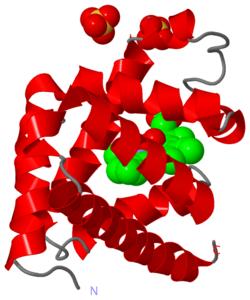JMS/sandbox15
From Proteopedia
(Difference between revisions)
| Line 28: | Line 28: | ||
Another way to say this, in the case of proteins <scene name='57/575026/Electrostatics/16'>in solvents such as water</scene>, is that, for each and every protein, <scene name='57/575026/Electrostatics/24'>water binds to the hydrogens</scene> (e.g., lysine's ammonium at physiology pH has three hydrogens - not shown) coming off a positively charged atom, or associates with the charged atom itself, thus screening each protein from the other proteins. | Another way to say this, in the case of proteins <scene name='57/575026/Electrostatics/16'>in solvents such as water</scene>, is that, for each and every protein, <scene name='57/575026/Electrostatics/24'>water binds to the hydrogens</scene> (e.g., lysine's ammonium at physiology pH has three hydrogens - not shown) coming off a positively charged atom, or associates with the charged atom itself, thus screening each protein from the other proteins. | ||
| - | Still, this picture is incomplete. While illustrative of the basic principles of how small electrostatic fields changes can greatly increase a protein's solubility, there other contributing factors to the electrostatic field, e.g., solvated ions, crowding conditions, and the neighboring residues to these divergent residues. For example, when a negatively charged residue neigbors one of these additional positive residues, then from a distance relatively larger than the distance between the two oppositely charged residues, the electrostatic field is zero. | + | Still, this picture is incomplete. While illustrative of the basic principles of how small electrostatic fields changes can greatly increase a protein's solubility, there other contributing factors to the electrostatic field, e.g., solvated ions, crowding conditions, and the neighboring residues to these divergent residues. For example, when a negatively charged residue neigbors one of these additional positive residues, then from a distance relatively larger than the distance between the two oppositely charged residues, the electrostatic field is zero<ref>https://pdb101.rcsb.org/motm/1#:~:text=PDB%2D101%3A%20Molecule%20of%20the%20Month%3A%20Myoglobin.</ref> |
<!-- | <!-- | ||
Revision as of 08:37, 17 August 2023
| |||||||||||
References:
- ↑ 1.0 1.1 Mirceta S, Signore AV, Burns JM, Cossins AR, Campbell KL, Berenbrink M. Evolution of mammalian diving capacity traced by myoglobin net surface charge. Science. 2013 Jun 14;340(6138):1234192. doi: 10.1126/science.1234192. PMID:23766330 doi:http://dx.doi.org/10.1126/science.1234192
- ↑ Brocchieri L. Environmental signatures in proteome properties. Proc Natl Acad Sci U S A. 2004 Jun 1;101(22):8257-8. Epub 2004 May 24. PMID:15159533 doi:http://dx.doi.org/10.1073/pnas.0402797101
- ↑ Goh CS, Lan N, Douglas SM, Wu B, Echols N, Smith A, Milburn D, Montelione GT, Zhao H, Gerstein M. Mining the structural genomics pipeline: identification of protein properties that affect high-throughput experimental analysis. J Mol Biol. 2004 Feb 6;336(1):115-30. PMID:14741208 doi:http://dx.doi.org/10.1016/S0022283603014748
- ↑ https://pdb101.rcsb.org/motm/1#:~:text=PDB%2D101%3A%20Molecule%20of%20the%20Month%3A%20Myoglobin.

